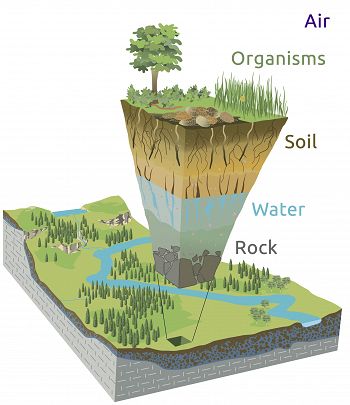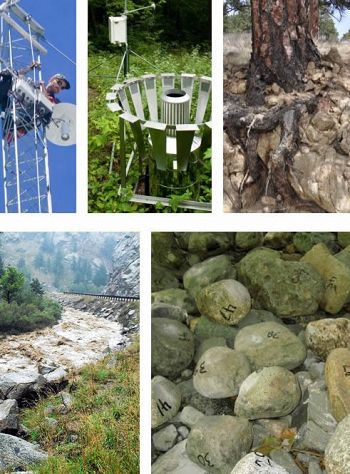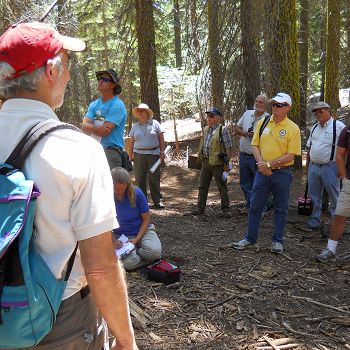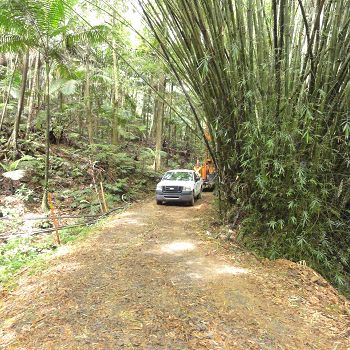The Critical Zone
Earth's permeable near-surface layer... from the tops of the trees to the bottom of the groundwater.
It is a living, breathing, constantly evolving boundary layer where rock, soil, water, air, and living organisms interact. These complex interactions regulate the natural habitat and determine the availability of life-sustaining resources, including our food production and water quality.
Explore the Critical Zone
View a 6.5 min video created by WSKG in collaboration with the CZO National Office:
The Critical Zone is Earth's outer skin
-
The zone where rock meets life.
-
A permeable layer from the tops of the trees to the bottom of the groundwater.
-
An environment where rock, soil, water, air, and living organisms interact and shape the Earth's surface.
Water and atmospheric gases move through the porous Critical Zone, and living systems thrive in its surface and subsurface environments, shaped over time by biota, geology, and climate.
All this activity transforms rock and biomass into the central component of the Critical Zone - soil; it also creates one of the most heterogenous and complex regions on Earth.
Critical Zone processes operate on second-to-eon timescales
The Critical Zone is imprinted by important events over seconds, hours, years, millenia, and geologic time. The present structure and functioning of the Critical Zone reflects:
- short-term responses to events like rainfall and human activities like land-use changes
- long-term responses to climatic and tectonic changes over geologic time
Critical Zone processes sustain life on Earth
The Critical Zone supports all terrestrial life. Its complex interactions regulate the natural habitat and determine the availability of life-sustaining resources, such as
- food production
- water quality
These are but two of the many benefits or services provided by the Critical Zone. Such "Critical-Zone Services" expand upon the benefits provided by ecosystems to also include the coupled hydrologic, geochemical, and geomorphic processes that underpin those ecosystems.
Human impacts on the Critical Zone are large, and vice versa
The Critical Zone and human society are closely intertwined, impacting each other in myriad ways. Two particularly important issues are
- climate change
- land use
There are many other issues including impacts on:
- soil quality
- stream flow and runoff
- contaminant transport
- the carbon cycle
Humans clearly affect the Critical Zone. Some examples:
- 30-50% of global land surface and 50% of freshwater has been used by humans.
- Croplands and pastures now rival forest cover as the major biome on Earth.
- Soil loss on U.S. croplands and pastures exceeds 1cm/yr at present.
- Contaminants have been documented in 80% of representative streams in the U.S.
The zone is not well characterized.
Despite the Critical Zone's importance to terrestrial life, it remains poorly understood. Fundamental questions include:
- How does the Critical Zone form?
- How does it function?
- How will it change in the future?
More specifically, too little is known about how physical, chemical, and biological processes in the Critical Zone are coupled and at what spatial and temporal scales. Many of these processes are highly nonlinear and can range across scales from atomic to global, and from seconds to aeons.
Understanding the complex web of physical, chemical, and biological processes of the Critical Zone requires a systems approach across a broad array of sciences: hydrology, geology, soil science, biology, ecology, geochemistry, geomorphology, and more.
More about the U.S. National CZO Program
The US National CZO Program is tackling the fundamental questions of the Critical Zone with a systems approach. You can find out more on the NSF CZO page or visit our About page.
You might also be interested in an older 7.5 minute video overview. The video was created in 2012, before the Program expanded from 6 to 9 observatories.
Produced in 2012 by Shipherd Reed (University of Arizona), this video features interviews with researchers from the Jemez-Catalina CZO. See transcript.
Interested in learning more?
The Critical Zone. Illustration modified from Chorover, J., R. Kretzschmar, F. Garcia-Pichel, and D. L. Sparks. 2007. Soil biogeochemical processes in the critical zone. Elements 3, 321-326. (artwork by R. Kindlimann). Image Request.
The Critical Zone is imprinted by events spanning from seconds to eons. Images: Sierra, Shale Hills, Boulder, and Luquillo.
Earth. Image: Nasa.
Image: Southern Sierra CZO.
Image: Luquillo CZO
Explore Further





